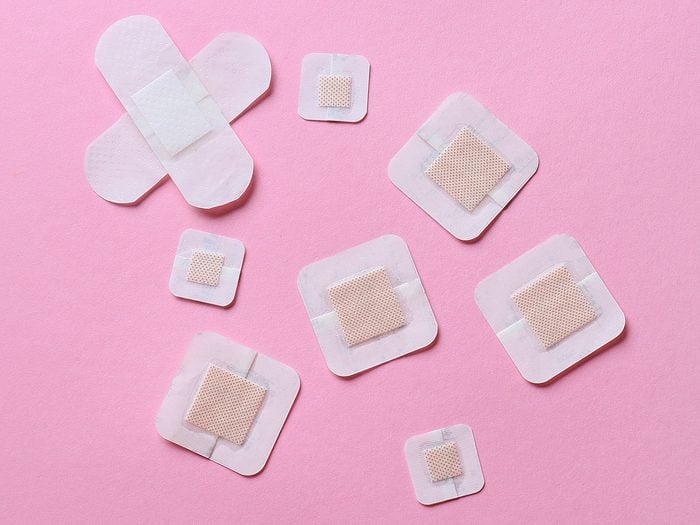Allergic Reactions to Adhesive Bandages Aren’t Pretty—But They’re Actually Common

If you discover a red, itchy and scaly rash under your Band-Aid, you have an allergic reaction. Here’s what to do.
I first heard about allergic reactions to adhesive bandages on—how most of us learn about weird things these days—TikTok. I was delivered an alarming video of a woman whose skin was oozing a golden yellow liquid after wearing a bandage for a few days. So when I recently saw the same yellowness (among other attractive symptoms) on my leg after peeling off a Band-Aid, I had a hunch about what had happened. How common, and serious, is this allergy?
According to Sandy Skotnicki, a dermatologist in Toronto, it’s not rare. “The most common bandage adhesive comes from the naturally occurring ingredient called colophony or rosin,” she says, which is a sticky golden resin that comes from the sap of pine trees. “Its stickiness lends itself to being used in a wide range of products,” says Skotnicki. People sometimes assume a natural ingredient is better for skin than a synthetic one, but both can lead to allergic dermatitis.
It took my reaction six weeks to heal—don’t be like me. Here’s how to prevent, spot and soothe an allergic reaction from an adhesive bandage.
How do you identify allergic dermatitis to adhesive bandages?
A tell-tale sign of a reaction is if you develop a red, itchy and scaly eruption in the exact location under a bandage, says Skotnicki. But it doesn’t appear right away—it can take 24-48 hours to develop.
“Allergic contact dermatitis is a delayed type of allergy,” she says. “There are two phases: In the first, a sensitization where the immune system in the skin recognizes the chemical in contact with it as foreign and develops an immune response against it. And in the second phase, every time the skin is in contact with the chemical going forward, an allergic contact dermatitis results as the immune system recognizes this chemical as foreign.”
What does it mean if skin reacts by also expelling a yellowish liquid?
“The more severe the contact allergy, the more severe the resulting allergic dermatitis,” says Skotnicki. This often means blisters develop in the top layer of skin and release yellow fluid.
How can you treat the reaction?
“Any allergic contact dermatitis can be treated with topical hydrocortisone,” says Skotnicki. Mild versions can be purchased over-the-counter at any drugstore, but a higher strength can be prescribed by a doctor, if necessary.
What can I use instead of Band-Aids?
Not all adhesive bandages contain colophony or rosin. Skotnicki recommends Band-Aid Tough Strips. Also, Patch bandages, available at Whole Foods, don’t contain the allergen either.
Are there any other potential allergens I should be aware of?
“Many newer bandage adhesives are made from the chemical class called acrylates,” says Skotnicki, “and many acrylates can also cause contact allergic reactions.” The good news is most bandages use proprietary acrylate adhesives, she says, and reports of allergies to them are low.
Next: Layering Skin Care Products—Am I Doing It Right?
Renée Reardin is an editor at Best Health and writes a newsletter called Curious Chat, where she finds answers to health-related questions just like this one. Subscribe below!




